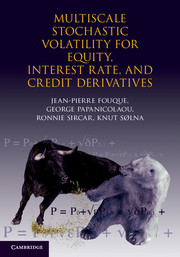Book contents
- Frontmatter
- Contents
- Introduction
- 1 The Black–Scholes Theory of Derivative Pricing
- 2 Introduction to Stochastic Volatility Models
- 3 Volatility Time Scales
- 4 First-Order Perturbation Theory
- 5 Implied Volatility Formulas and Calibration
- 6 Application to Exotic Derivatives
- 7 Application to American Derivatives
- 8 Hedging Strategies
- 9 Extensions
- 10 Around the Heston Model
- 11 Other Applications
- 12 Interest Rate Models
- 13 Credit Risk I: Structural Models with Stochastic Volatility
- 14 Credit Risk II: Multiscale Intensity-Based Models
- 15 Epilogue
- References
- Index
10 - Around the Heston Model
Published online by Cambridge University Press: 07 October 2011
- Frontmatter
- Contents
- Introduction
- 1 The Black–Scholes Theory of Derivative Pricing
- 2 Introduction to Stochastic Volatility Models
- 3 Volatility Time Scales
- 4 First-Order Perturbation Theory
- 5 Implied Volatility Formulas and Calibration
- 6 Application to Exotic Derivatives
- 7 Application to American Derivatives
- 8 Hedging Strategies
- 9 Extensions
- 10 Around the Heston Model
- 11 Other Applications
- 12 Interest Rate Models
- 13 Credit Risk I: Structural Models with Stochastic Volatility
- 14 Credit Risk II: Multiscale Intensity-Based Models
- 15 Epilogue
- References
- Index
Summary
Since its publication in 1993, the Heston model (Heston, 1993) has received considerable attention from academics and practitioners alike. The Heston model belongs to the class of stochastic volatility models described in Chapter 2. Among stochastic volatility models, the Heston model enjoys wide popularity because it provides an explicit, easy-to-compute, integral formula for calculating European option prices. In terms of the computational resources needed to calibrate a model to market data, the existence of such a formula makes the Heston model extremely efficient compared to models that rely on partial differential equations techniques or Monte Carlo simulations for computation and calibration.
In this chapter, we show that our asymptotic analysis can be applied to Heston's model in several ways. First, we approximate the Heston model in the two regimes where the CIR volatility factor is fast mean-reverting or slowly varying, and in each regime we derive formulas for the V parameters arising in the analysis presented in Chapter 4. The main advantages of this approximation technique are that, as for general stochastic volatility models treated before, the computation and calibration steps simplify vastly, which in turn enables consistent pricing of more complex derivatives.
As has been explained in previous chapters, a single factor of stochastic volatility is not enough to capture the main features of the implied volatility surface.
- Type
- Chapter
- Information
- Publisher: Cambridge University PressPrint publication year: 2011



